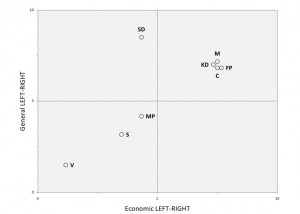What does the December Agreement achieve? In the short-run, the agreement provides governmental stability. This is how the PM, Stefan Lofven saw it: “Sweden can be governed.” In this respect, the deal is unremarkable. Minority governments strike outside-support deals (i.e., deals that fall short of formal coalition) all the time. Also, in the short-run, the agreement avoids a snap election. This is probably explains the right bloc’s willingness to enter into the agreement: the right parties, and the largest of them, the Moderate Party, got walloped at the last election. For the right parties, a snap election carried with it a high risk of i) the governing left parties increasing their level of support, and/or ii) the populist Swedish Democrats establishing an even stronger parliamentary presence. That’s in line with recent polling.
I’d also posit a third longer-run objective, and that is to establish a cordon sanitaire around the Swedish Democrats to keep them at the parliamentary and political fringe. One can make a normative argument that it’s desirable to limit the power of extremists. That said, the agreement also helps the established parties to preserve their oligopolistic position in Swedish politics. In this sense, the December Agreement is a classic example of established political parties behaving as a cartel* and trying to freeze out an upstart competitor.
There are two dimensions to this cartel-like behaviour. One dimension concerns the division of votes, seats, and bargaining power. Ostensibly, the December Agreement undercuts the pivotal position of the Swedish Democrats in the legislature, and in doing so the hope is presumably to make voters see votes cast for the Swedish Democrats as wasted votes. A second dimension relates to the “ideological topography” of Swedish politics. A noted in my previous post, Swedish politics has traditionally run along a left-right class/economic dimension. The Swedish Democrats threaten this unidimensional model of politics; they want to talk about issues of nationalism and immigration that cross-cut the left-right divide. A Masters thesis that uses the Swedish party manifestos to estimate the parties’ positions captures this idea nicely.**
Notice how the established parties fall almost perfectly along the diagonal of this two-dimensional space, with only the SDs falling away from that pattern. Thus, without the Swedish Democrats, political competition in Sweden would continue to be unidimensional in nature, the established parties distinguished mainly in economic left-right terms, with minor policy differences defining unique electoral segments within each bloc (e.g., the Greens using environmentalism to distinguish themselves from the Social Democrats.)
The electoral strength and legislative presence of the Swedish Democrats entirely upsets this unidimensional pattern of political competition: it forces the established parties either 1) to take up positions on immigration, nationalism, internal security etc. that divide both parties and blocs internally, or 2) to ignore such issues and potentially lose votes to the Swedish Democrats.
One can see the December Agreement as an effort to collapse this second dimension of political competition.
*Katz, R. S., & Mair, P. (1995). Changing models of party organization and party democracy the emergence of the cartel party. Party politics, 1(1), 5-28.
**Backlund, Anders. 2011. “The Sweden Democrats in Political Space– Estimating policy positions using election manifesto content analysis.” MA Thesis. Department of Social Sciences, Södertörn University .


 Follow
Follow